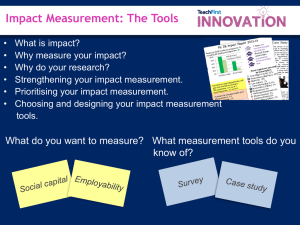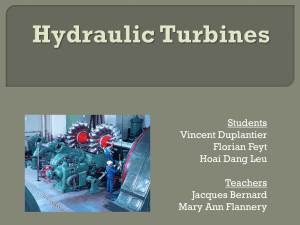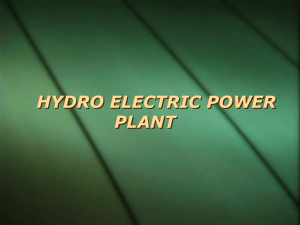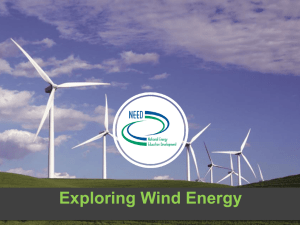Feasibility of a Unique Wind
advertisement
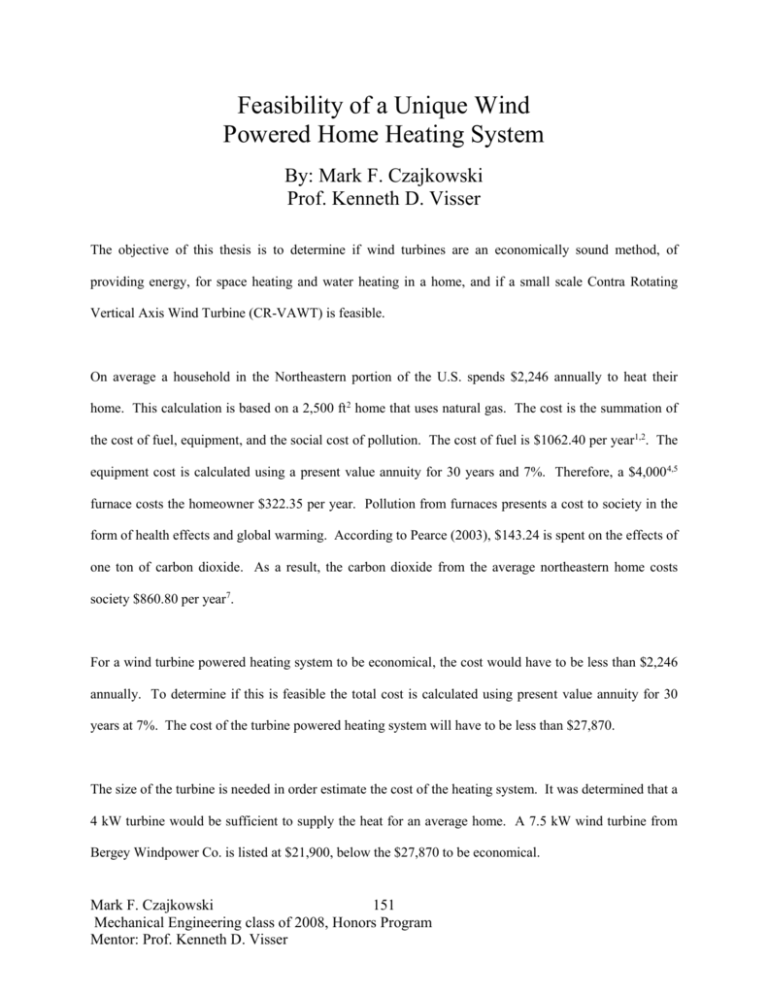
Feasibility of a Unique Wind Powered Home Heating System By: Mark F. Czajkowski Prof. Kenneth D. Visser The objective of this thesis is to determine if wind turbines are an economically sound method, of providing energy, for space heating and water heating in a home, and if a small scale Contra Rotating Vertical Axis Wind Turbine (CR-VAWT) is feasible. On average a household in the Northeastern portion of the U.S. spends $2,246 annually to heat their home. This calculation is based on a 2,500 ft2 home that uses natural gas. The cost is the summation of the cost of fuel, equipment, and the social cost of pollution. The cost of fuel is $1062.40 per year1,2. The equipment cost is calculated using a present value annuity for 30 years and 7%. Therefore, a $4,000 4,5 furnace costs the homeowner $322.35 per year. Pollution from furnaces presents a cost to society in the form of health effects and global warming. According to Pearce (2003), $143.24 is spent on the effects of one ton of carbon dioxide. As a result, the carbon dioxide from the average northeastern home costs society $860.80 per year7. For a wind turbine powered heating system to be economical, the cost would have to be less than $2,246 annually. To determine if this is feasible the total cost is calculated using present value annuity for 30 years at 7%. The cost of the turbine powered heating system will have to be less than $27,870. The size of the turbine is needed in order estimate the cost of the heating system. It was determined that a 4 kW turbine would be sufficient to supply the heat for an average home. A 7.5 kW wind turbine from Bergey Windpower Co. is listed at $21,900, below the $27,870 to be economical. Mark F. Czajkowski 151 Mechanical Engineering class of 2008, Honors Program Mentor: Prof. Kenneth D. Visser The Bergey excel, 7.5 kW turbine and the Wisper 500, 3.2 kW turbine are priced below $27,870 and it would be economical for a homeowner to install the turbine to heat their home. Furthermore, the turbine comes with equipment to connect it to either a battery bank or the electric grid. This equipment is costly and would not be necessary if the turbine was connected to a heating system. The heating system would use an immersion heater, which is an enclosed resister. The resister can accept electricity at any frequency, unlike the power grid that needs 60 Hz. Vertical axis wind turbines (VAWT) have been around for many years and have many advantageous that a small homeowner could take advantage of. A VAWT is a relatively simple design, does not need to track the wind direction, could perform better in turbulent wind, and the generator can be located near the ground for easier maintenance. A CR-VAWT is two VAWTs on the same tower that spin opposite directions. The CR-VAWT is advantageous because the RPM at the generator is higher than a comparable VAWT. There is no record of a CR-VAWT being researched or on the market; therefore, this research is to test the feasibility of the concept. A test turbine was designed in SolidWorks and is shown in Figure 1. The turbine has been built, Figure 2, and will be tested in Clarkson University’s wind tunnel. Mark F. Czajkowski 152 Mechanical Engineering class of 2008, Honors Program Mentor: Prof. Kenneth D. Visser Figure 1: CR-VAWT SolidWorks model Figure 2: CR-VAWT Prototype A similar type of turbine has been research at Clarkson University over the past three years, the contra rotating horizontal axis wind turbines (CR-HAWT). The main issue with the turbines was that both rotors spun the same direction even though their blades were positioned such that they should spin in opposite directions. It was suggested that the forces, that spin the generator, were causing the unanticipated result. Rotors with different solidity were tested to try to balance to torques. The turbine did work, but was inconsistent and difficult to keep both rotors from spinning the same direction.8 Testing of the CR-VAWT will be done to determine if a CR-VAWT is feasible, and to gain more knowledge on contra rotating turbines. When designing a test turbine, the problems with the horizontal axis wind turbine was taken into consideration. Therefore, if the torque from one turbine is more powerful then the other, the turbine has designed such that the diameter of the outside rotor can be changed, and therefore the torque from the outside rotor can be changed. It is hypothesized that if the torques from both rotors are the same, the turbine will function correctly. Mark F. Czajkowski 153 Mechanical Engineering class of 2008, Honors Program Mentor: Prof. Kenneth D. Visser Reference: 1. Energy Information administration, 2001 Space-Heating Energy Consumption in U.S. Households by Four Most Populated States, 2001, Residential Energy Consumption Survey 2. Energy Information administration, 2001 Water-Heating Energy Consumption in U.S. Households by Four Most Populated States, 2001, Residential Energy Consumption Survey 3. Energy Information Administration, March, 2007, U.S. Natural Gas Residential Price (Dollars per Thousand Cubic Feet), 4. Besley, S., Brigham, E.F., 2006, Principles of Finance, Third Edition, Thomson South Western 5. Energy Information administration, 2001 Water-Heating Energy Consumption in U.S. Households by Four Most Populated States, 2001, Residential Energy Consumption Survey 6. Pearce, D., Nov. 2003, THE SOCIAL COST OF CARBON AND ITS POLICY IMPLICATIONS, Oxford Review of Economic Policy. Vol.19, Iss. 3; pg. 362 7. D&R International, Ltd., September 2006, 2006 Buildings Energy Data Book, U.S. Department of Energy 8. Rector, M. C., 2007 “Feasibility Study of a Small Contra-Rotating Horizontal-Axis Wind Turbine” Clarkson University Mark F. Czajkowski 154 Mechanical Engineering class of 2008, Honors Program Mentor: Prof. Kenneth D. Visser




